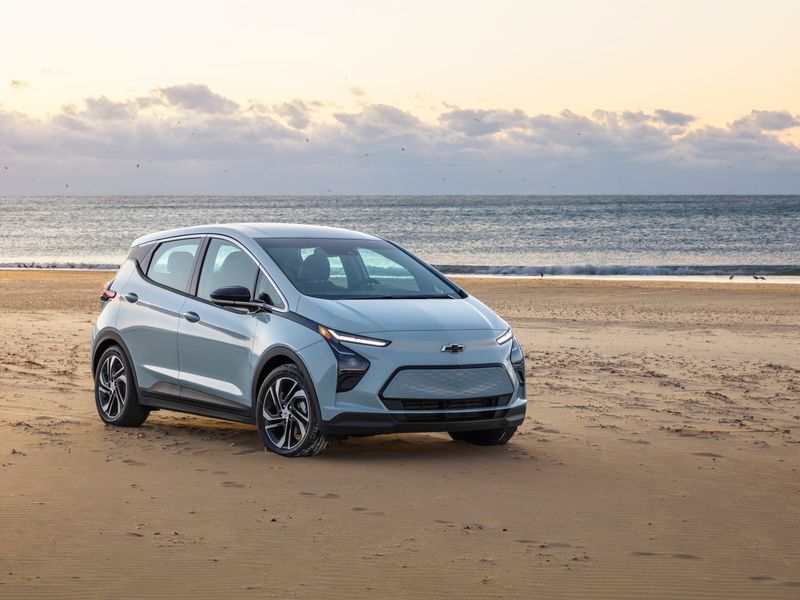
Chevrolet has expanded its electric vehicle lineup with the all-new Bolt EUV, a longer version of the Bolt with more legroom. At the same time, the standard Bolt EV has been updated for 2022. Both are front-wheel-drive only and marketed as crossovers but operate and handle more like hatchbacks, with compact footprints and easy maneuverability. The two vehicles are built on the same architecture but do not share any exterior sheet metal, Chevy said.
The Bolt’s chassis and powertrain remain the same but styling and the tech-focused cabin have been freshened for 2022. Safety and connectivity are enhanced as well, along with the quality and styling of the interior.
Most significantly, the Bolt has been reduced in price from $36,500 for the 2021 model to $31,000.
It is equipped with the same electric motor and 65-kWh lithium ion battery pack as before, with a range of 259 miles. The Bolt EUV looks similar to the standard Bolt EV but shares no body panels. We’ve rounded up some early reviews of the Bolt EV, which sometimes overlap with the Bolt EUV, which was reviewed separately in March.
“Front and center is a 10.8-inch screen now home to Chevrolet’s Infotainment 3 software. This interface is much easier to navigate than the old, Bolt-specific setup, and is less reliant on standard Android Auto and Apple CarPlay for basic functionality — though both phone connectivity suites are still supported and can now be connected wirelessly.
The Bolt excels as a commuter car, boasting 259 miles per charge according to the EPA’s estimates. That range estimate is unchanged from last year despite an ever-so-slightly smaller 65-kilowatt-hour battery (a 1-kWh reduction). This range is still enough to edge out the competition from Hyundai, Kia and Nissan, but continues to fall behind the Tesla Model 3.
Home charging is potentially faster with this year’s upgrade to up to 11.5-kW Level 2 charging — though you’ll need to make sure that your home can support the extra current and install a 48-amp wall charging unit to take full advantage. This reduces the charge time to around 7 hours versus the 10-hour estimate if you plug the dual-level charging cord straight into a NEMA 14-50 outlet. Of course, you can also trickle charge at almost any standard 110-volt wall outlet, but that only adds around 4 miles of range per hour.
Having been spoiled by newer, more upmarket EVs, I was a touch disappointed to learn that the Bolt can still only DC fast charge at around 55 kW max. That means getting a boost to 80 percent capacity at a rapid charge station takes about an hour.
The Bolt features a few different driving programs. There’s Normal and Sport, the latter adjusting the accelerator sensitivity for more responsive driving. Then again, with 200 hp and 266 pound-feet of instant electric torque, the Bolt feels great off the line in either mode.”
— Antuan Goodwin, Road Show by CNET
“My driver impressions of the first Bolt I drove back in 2017 were very positive, and this new Bolt EV just improves on that. In particular is the regenerative braking function, not something you’d typically lump in with driving attributes, but Chevrolet engineers’ unique take on restoring energy to the battery pack was a revelation four years ago and continues to be in the new model. What I don’t understand is why no other automaker has copied it.
Unlike so many electric vehicles that have their regen settings embed in menus accessed through infotainment screens or with buttons on the center console, the Bolt’s is a small paddle-shift-like device mounted at 9 o’clock on the steering wheel. Instead of setting a regen mode, you simply pull back on the paddle and hold it to activate regen, allowing you to feather the intensity of the regen depending on the road grade. In a place like my hometown of Vancouver, this provides a great way to brake on downhills without even touching the brake.”
— Andrew McCredie, Driving
“The interior sees the biggest change for the Bolt EV with a new design shared with the EUV. It’s more horizontally oriented with a center stack that’s less podlike. In front of the driver is an 8-inch digital instrument cluster. The standard 10.2-inch infotainment touch screen returns, but it has an all-new user interface, plus support from wireless charging (standard on EUV, available on EV), and standard wireless Apple CarPlay and Android Auto. The Bolts offer new in-vehicle apps such as Spotify, Weather Channel and Amazon Alexa. A 4G Wi-Fi hotspot is also available.
Like any EV, both versions of the Bolt feel peppy at low speeds, but they’re especially eager to spin the front tires off the line with a full boot to the right pedal. Accelerative forces normalize about halfway down the freeway onramp. All the while, the Bolts are supremely quiet to drive, especially on smooth pavement, providing a tranquil environment when you’re not spinning the front tires and flinging the car around corners.
The Bolt retains the Regen-on-Demand lever that adds maximum regenerative braking when you pull a button on the back of the steering wheel, but there’s now also a button you can press to toggle between regular and one-pedal driving.”
— John Beltz Snyder, Autoblog

